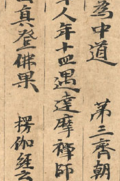中古佛教寫本資料庫工作手冊
中古佛教寫本資料庫工作手冊
The Database on the Grammar of Medieval Chinese
Date: 2015-7-01 Author:Lin Ching-hui 林靜慧
本計畫為中華佛研所與根特大學根特佛學研究中心的合作專案。由洪振洲(Hung Jen-jou)、安東平(Christoph Anderl)主持,馬德偉(Marcus Bingenheimer, Temple University)、張伯雍 (Zhang Boyong)擔任顧問。
工作流程
一、下載所需敦煌寫卷影像檔,並在PDF檔上標好行號。
二、搜尋寫卷內容是否有文字檔,若有文字檔則下載;若沒有則將影像檔初步打成文字檔。
三、細部分辨寫卷字形,用PA++或OXYGEN開啟寫卷文字檔(XML檔),在文字檔的基礎上,開始加上標記語言。
注意事項:
1注意標記語言的使用(參見「標記語言使用表」)
2遇到unicode有的異體字,需同時維護異體字庫(參見檔案「00-variant-table-Ms-Project」),並注意程式只能判斷一組正字與異體字的關係,所以如果該異體字另兼正字,那麼就不能列入該檔中,需用人工輸入,以免因程式無法分辦而造成混亂。
3遇到unicode沒有的異體字,需到「教育部異體字典」找出對應字與下載字圖,存入異體字圖庫(參見檔案「gaiji」);若是異體字典沒有對應的字,先標明缺字並記錄該字的卷號行號字號,稍後需要造字。(如果將來出版實體書,這些unicode沒有的異體字圖檔皆需造字,將圖檔改成文字。)
四、完成標記後,用oxygen轉成原抄本檔與標準字檔,初步檢查是否有誤。。
五、最後用freecommandXE程式將異體字庫中的異體字轉成<orig reg="X">(X代表教育部規範之正字),最後再檢查是否有誤。
PS:注意標明資料來源。
PS2:所使用的標記規範為 TEI P5
編碼語言使用說明
異體字或通同字的情況
在標明異體字或通同字時使用,標為:<orig reg="X">Y</orig>(X代表教育部規範之正字,Y代表異體字或通同字)。 1、當X為unicode所沒有的字時,則代換成<g ref="#Z"/>:Z代表教育部異體字典中的字碼或缺字的卷行字號。 2、檔案「00-variant-table-Ms-Project」中的異體字,程式會自動轉成<orig reg="X">的編碼並出現type(unicode常用罕用字分類),但是若在<orig reg="X">中放進「00-variant-table-Ms-Project」有的異體字,程式會自動略過,字形不會產生變動,因此若遇到一字兼兩種正字的異體時,要選擇其中一種人工輸入,如仏字同時是佛與似的異體字,「00-variant-table-Ms-Project」檔中已選擇仏作為佛的異體,程式只會自動將仏轉成佛,那麼遇到似的異體時,便要標為:<orig reg="似">仏</orig>。 3、所謂通同字,意指兩字有時有通用的情形,又各自另兼正字,如:鍾鐘為通同字,但其各有本義,鍾為酒器,鐘為樂器,在「二口金鍾」此文之鍾字作樂器解時,其本字當為鐘,此時編碼作<orig reg="鐘">鍾</orig>;又如:「有願尅從」,剋與尅為同音同義的通同字,克與剋為通同字,此文尅當作「能夠」解,克與尅都有「能夠」之意,而此尅依據教育部字典考定為:因與正字剋形體相近而成為常用之俗寫異體字,此時編碼作<orig reg="剋">尅</orig>。 4、或有因字形相近,導致書寫習慣將兩字通同者,如:无(無的異體)與元,師與帥,客與容,雨與兩,此雖非通同字,但有通用的事實,故依通同字例。
錯字或假借字的情況
在標明錯字或同音通假時使用,標為:<choice><sic>A</sic><corr>B</corr></choice> (A代表錯字,B代表正確的標準字),若有他本可以作為校勘證據,便用<note>說明出處(出處可使用簡稱,並在凡例中將完整出處說明)。 1、當A為unicode所沒有的字時,則代換成<orig reg="X">Y</orig>。 2、所謂假借字,意指因同音或音近而造成的錯字,如: 「吝此明珠如姓明」,姓明二字語義不通,當為性命之同音假借的錯字,此時標為:<choice><sic>姓明</sic><corr>性命</corr></choice>。 3、形近而誤的錯字,如:「跂覢電作朱旗」,跂乃形近跛而誤,而跛與披音近通假,有另一版本P-2187降魔變押座文與本卷之語為證,故標為:<choice><sic>跂</sic><corr>跛</corr></choice><note>本卷95行有跛旗之語,故知跂為跛之誤,且跂覢二字P-2187作披閃,蓋跛假作披。</note>
特殊符號的使用情況
1、在標明倒乙符號時使用(有㆑與乙兩種符號,依實際情況使用),標為:<orig reg="日月">月<add place="inline-right">㆑</add>日</orig>。 1)倒乙字若是unicode有的異體字,則標為:<orig reg="珍珠">珠<add place="inline-right">㆑</add><orig reg="珍">珎</orig></orig>。 2)倒乙字若是unicode沒有的異體字,則標為:<orig reg="珍珠">珠<add place="inline-right">㆑</add><orig reg="珍"><g ref="#A02563-001"/></orig></orig>。 2、在標明省書符號時使用,如𦬇為菩薩的省書符號,則標為:<choice>卄卄<expan>菩薩</expan></choice>。 3、在標明重文符號(〻)時使用,標為:<choice>日〻<expan>日日</expan></choice> 1)重文字若是unicode有的異體字,則標為:<choice><orig reg="驅">駈</orig>〻<expan>驅驅</expan></choice> 2)重文字若是unicode沒有的異體字,則標為:<choice><orig reg="役"><g ref="#A01277-001"/></orig>〻<expan>役役</expan></choice>。
在標明文字經過正規化的判定時,不同的情況使用不同的標號,如:
1、<unclear>:當文字墨色模糊(如:退色或磨損)或文字筆畫不清(如:草書)難以判斷,需依賴上下文才能判讀時使用,若需要其他文獻校勘才能判讀時,便加上<note>說明文獻出處:
1)若筆畫雖然不清楚,但仍能判斷該字,則依然使用<orig reg="X">。如: (S-3491-059)雖然是筆畫不清楚的駈(驅的異體字),因其有50%以上的把握是駈,故依然用<orig reg="驅">駈</orig>;若是遇到無法辨識清楚的字,才用<unclear>(原有的<reg>標號不用)。
2)若是異體字的字形不清楚,亦直接以<unclear>包覆正字,不再使用<orig reg="X">或<choice>。因為若是標成:<reg>駈<reg>,到時用freecommandXE程式轉檔時,字會無法顯示出來;若是標成:<reg>驅<reg>,便無法表現出異體字駈。
2、<damage>:當文字破損,但仍可辨識時使用。
1)若因破損而無法辨識,則標成:<damage unit="char" extent="1"/>,若是完全無法分辨字形,則標成:<gap unit="char" extent="1"/>。
2)破損嚴重,需參酌他本,理校出正字,則標成:<choice><unclear><damage unit="char" extent="1"/></unclear><reg>X</reg></choice>:X代表理校出的正字。
PS:<unit="chars"> 是早期的標記,現在統一作 unit="char"。
3、<expan>:只在表示的縮寫還原時使用, <expan> 標記中已視為「正規化」,故不再有如 <reg>或<unclear> 等標記。
==刪除標記== 1、當某字被刪去時,標為:< del>Z</ del>:X代表被刪去的字,若被刪去為異體字,Z則代入<orig reg="X">Y</orig>。
2、當某字被刪去後,又在其右邊加上改正的字時,標為:<subst>X<add place="inline-right">Y</add></subst>。
3、當某字被塗毀時,導致無法辨別字體時,標為:。
4、當某字因錯誤而被添加筆畫改成正確的字時,標為:<subst>X<add>Y</add></subst>(X代表原錯字,Y代表被改正的字)。
插入標記
1、在字的右邊插入文字時,標為:<add place="inline-right">X</add>X代表放在行外右邊插入的字。
2、在筆劃不清的字右邊插入文字時,標為:<subst><add place="inline-right">X</add></subst>:X代表被放在行外右邊插入的字。
3、同一行中,先刪去某字,隨後寫上正確的字時,標為:XY:X代表被刪去的字,Y代表改正的字。
4、在錯字上修正筆畫改成正確的字時,標為:<subst>X<add>Y</add></subst>:X代表原本寫錯的字,Y代表改正後的字。
5、當被刪去的某字被塗毀而無法辨識,又在右邊加入改正字時,標成:<subst><gap unit="char" extent="1"/><add place="inline-right">X</add></subst>:X代表被放在行外右邊插入的字
6、當被刪改後的錯字為誤時,在<choice><sic>X</sic><corr>Y</corr></choice>後加上<note>作說明。
標點標記
1、一般標點標為:<pc>X</pc>:X代表標點符號。 2、當標點剛好落在重文符號中間時,如:以手遮<choice>日〻<expan>日日</expan></choice>光所下之䖏,兩個日中間當斷句時,可標為:<expan>日<pc>,</pc>日</expan>或是日<pc>,</pc><choice>〻<expan>日</expan></choice>
注解標記
1、公開給讀者看的說明,標為:<note>X</note>:X代表注解內容。 2、編碼者給自己看的提示(不會公開顯示),標為:。 3、敦煌變校注的錨點(目前顯示為□):<anchor type="dh-bw-jiaozhu" n="001"/>。 4、小字雙行夾注,標成:<hi rendition="#inline-para">X<lb/>X</hi>:X代表夾注內容,<lb/>代表換行點。 5、後人寫的雙行小字注解文字,標成:<note resp="hand2" rendition="#inline-para">其像兩<lb/>足返</note> 6、後人寫在右邊注解文字,標成:<note resp="hand2" rendition="#inline-right">下其頭上有冠</note>
空格標記
1、偈語的空格:<space type="verseSpacing"/> 2、段落的空格:<space type="punctuation" unit="char" extent="1"/> 3、無意義的空格:<space type="simpleSpace" unit="char" extent="1"/>
更正標記
1、一般錯字:<choice><sic>雈</sic><corr>舊</corr></choice> 2、一字誤拆為二字:<choice><sic>自㤪</sic><corr>臰</corr></choice> 3、一字誤拆為二字,並換行:<sic>五</sic><lb/><sic corr="尖">人</sic>
標記語言範例表
修改中
標記規則
一、標準字 1、字形筆畫與標準字相同者,即標示標準字,如: :碧。 2、字形與標準字大致相同,但筆畫因書寫習慣而有細部不同時,即標示為標準字,如: :於, :捉, :本, :此。 3、當字形可辨識為某字,但細部筆畫不易辨識時,即標示為<unclear>標準字</unclear>,如: :< unclear >繡</ unclear > ; :< unclear >數</ unclear >。 二、異體字-當字形筆畫與標準字有結構性的不同,而此不同並非因為書寫習慣(如:草書筆畫不定)造成時,判定為異體字(包含通同字)。 1、unicode有字,且教育部異體字典有收錄者,標示unicode字型(freecommandXE程式將異體字庫中的異體字轉成< orig >,但若已被包在< orig >中的異體字則不會被改動),如: :𦰧,但該字若另兼正字或另兼別字異體,程式無法判斷,如:仏既為佛之異體,又為似之異體,當其作為佛之異體字時,因為異體字表中有登記,故只須寫成仏,若作為似之異體字時,則標成<orig reg="似">仏</orig>。 2、unicode有字,而教育部異體字典無收錄者,標示unicode字型,處理同上例1。 3、unicode無字,而教育部異體字典有收錄者,如: 教育部異體字碼為A04204-023,故標成:<orig reg="那"><g ref="# A04204-023"/></orig>。 4、unicode無字,而教育部異體字典無收錄者: 1)字形與異體字典無明顯不同者,標示同上例3,如: 標成:<orig reg="數"><g ref="# A01739-038"/></orig>。 2)字形與異體字典有明顯不同者,標為專案編定字碼,如: 標為:<orig reg="福"><g ref="#S-2113-036-09"/></orig>。 PS是否需要把異體字典的字碼編入,成A02901-S-2113-036-09? 5、古今通用字,兩者字形不同,但為古今字或有通用的情形,標例同異體字:如:紅旗初<choice><orig>辰</orig><reg>震</reg></choice> <note>《說文》段注云:辰,震也。震振古通用,此亦可作振。</note>。 三、錯字-當字形筆畫與標準字有結構性的不同,且確定其與音義標準字也不同,判定為錯字(包含同音通假、形近而誤)。一般錯字標示為<choice><sic>錯字</sic><corr>標準字</corr></choice>,其後加<note>判定錯誤的依據</note>,如: 1、形近而誤:如:雹子空中自消<choice><orig>客</orig><reg>溶</reg></choice><note>本卷客容不分,此處客當作容,而容通溶。</note>。 2、同音通假:恡此明珠如<choice><orig>姓明</orig><reg>性命</reg></choice> <note>蘇遠鳴:〈敦煌石窟中的瑞像圖〉</note>。 伍、所見異體字表-持續編寫中
寫卷結構與標記
- 以敦煌寫卷「件」為單位,即每一個檔案即為一件敦煌寫卷(如 S.4272)
進階說明──文字迻錄原則
- 原則一、不論原文使用何種字體(楷書、行書、草書等),皆迻錄為楷書(楷化)。
- 原則二、Unicode 有提供字型者,按原字形迻錄。如:㘴,不改成為教育部標準字體(正字)「坐」。
Non-Unicode Variants - attested 萬國碼未收之異體字──已確認
|
Ex.1: S-4272-0002: 為除忘相<choice><orig><g ref="#A03335-004"/></orig><reg>修</reg></choice>行六度 |
|
Non-Unicode Variants - unattested 萬國碼未收之異體字──未確認(專案新增)
|
Ex.1: S-4272-0022: 度眾生過去<choice><orig><g ref="#S4272-022-14"/></orig><reg>逢</reg></choice>无量恒 |
|
"Unclear" Characters 模糊字
|
Ex.1: P-3703-0002:
無有邊<unclear>畔坐</unclear> |

|
Significant spaces 文中的空格
|
Ex.1: S-4272-0008 - S-4272-0010:
為中道<space unit="char" extent="2"/>苐三齊朝 人年十四遇達摩禪師 真登佛果<space unit="char" extent="1"/>楞伽経云 |

|
Character(s) added in the Ms. 插入字
|
Ex.1: S-4272-0009:
禪師俗<add place="inline-right">性</add>姖武窂人 |
|
| Character(s) Overwrite other Character(s): 覆蓋字
被覆蓋的字若不清楚則使用 |
Ex.1: S-4272-0021:
為是知眾生識<subst><del unit="char" extent="1"/><add>心</add></subst>自度 |
|
| Damaged but recognizable characters 破損字
<damage>與<unclear>近似,標記中直接使用正字。(範例中的字也可以識別為「忕」或「𢗗」,此處依另一版本。)<damage> is similar to <unclear> in that the text provided should be considered 通用字 as the variant can not be distinguished clearly. |
Ex.1: P-3703-0001 :
時<damage>狀</damage>𠰥 |

|
Unrecognizable characters due to accidental damage (tearing, breaking, smearing, blotting, smudging etc.) with later annotation 因意外而造成無法判讀(如撕裂、破損、磨滅、髒汙等),後來新增者
|
Ex.1: P-3703-0007:
In the header: <profileDesc> <creation> <listChange> <change xml:id="stage1">The manuscript is written, corrections were made by the scribe.寫卷抄錄時的修正</change><change xml:id="stage2">The verso is written. Ink seeps through blotting some characters.背面抄寫時的墨透背後所汙染者</change><change xml:id="stage3">A later hand clarifies characters that were blotted out.在汙處外再次訂正</change> </listChange> </creation> </profileDesc> 非<unclear>離</unclear>生<damage change="#stage2">法</damage><add change="#stage3" hand="2" place="inline-right">法</add><damage change="#stage2"><del change="#stage1" hand="1" unit="char" extent="1"/><add change="#stage1" place="inline-right" hand="1">有</add></damage><add change="#stage3" hand="2" place="inline-right">有</add>无生龍 一切圡木<damage change="#stage2">瓦</damage><add place="inline-right" change="#stage3">瓦</add>石
|

|
Reverse Mark 倒乙符號 (レ-点)
|
Ex.1: P-3436-0037:
亦出<add place="inline-right">㆑</add>不扵有 |
|
Repetition / Iteration Mark 叠字符號
|
 P-3664-0500 P-3664-0500
| |
Abbreviations 省書符號
|
Ex 1:P-3664-0511
<choice><abbr>阿〻<reg>難</reg>〻</abbr><expan>阿難阿難</expan></choice> |

|
| Ex 2:P-2634-0010
<choice>卄卄<expan>菩薩</expan></choice> |

| |
| Ex 3:S-2054-0325
<lb xml:id="S-2054-0325"/><choice><abbr>〻</abbr><expan>色</expan></choice> |

|
字型工具
- 最好安裝 Unicode Super-CJK Fonts v6.0





















